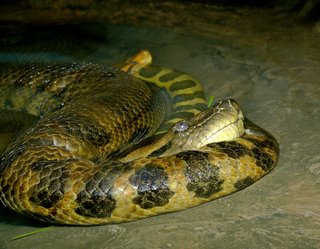 Anaconda
AnacondaA type of boa (which means it constricts or squeezes its prey to death) is found mainly in South America but the name comes from Tamil attributed by the Sinhalese (Sri Lankans) "Anaikolra". These snakes are non-venomous but use their large jaws which are loosely hinged to swallow their prey whole, irrespective of prey size. They live about 30 years in the wild and give birth to live young after a gestation period of 6months. Primarily found in the Amazon and swamps of South America, these water snakes get as long as 30 feet and weigh as much as 550lbs. They tend to lie submerged in water with their eyes above the water's edge. They are prone to ticks and leeches attaching to their bodies on land, but in water they release a chemical which keeps these natural annoyances at bay. These large snakes can spend up to two years digesting a BIG meal. Makes you wonder why camels got the prize in the popular idiom of animal fasting.
 King Cobra
King CobraThere are plenty of varieties of Cobra but the King Cobra interested me the most as I was almost bitten by one as a young child spending her summer in a village in the South of India--my sweet pomeranian, Rueben met his death barking at my defense...he was a sweet fluffy bundle of white love and unlike Luckey NEVER gnawed at my digits--but I digress. King cobras build a nest for their young and both parents take turns guarding the eggs (20-40 are laid and take 60-90 days to hatch). They live to be about 20 years old. Unlike most cobras, the king cobra is aggressive and raises his hood ready to fight in a confrontation. He senses his enemy with flicks of the tongue gauging temperature and feeling the vibrations of sound on the ground as he slithers about. The fascinating aspect of the king cobra that illustrates why he is KING is that he can spit his lethal venom up to 1/2 the length of his body with accuracy. A single bite has enough venom to kill an elephant or 10-13 human beings. That said, every bite is not venomous--the cobra can choose whether or not to inject his victim with his venom. Baby cobras are called hatchlings while a group of cobras is called a "quiver"....just the thought of it has me a quiver. They are found in Southeast Asia and Africa.
 Western Diamondback Rattlesnake
Western Diamondback RattlesnakeRattlesnake
While there are a multitude of varieties of rattlesnakes--in the US alone Sidewinders and diamondbacks are the predominant types but others exist as well--they all share the common trait of the female carrying the eggs inside herself and once they hatch live snakes abound. Rattlers develop a rattle each time they molt (shed their skin)--this may occur up to three times while they are growing for the first 3-4 years but slow to an annual rate as they age. Rattles can also break or fall off over time so counting rattles is not always the best measure of a age. After 7-10 days in their mothers' vicinty they break away to find food--the little rattlers are born with all the poison they will need to survive--though most don't make it past the first few months dying of starvation or preyed on by birds. They hibernate through the winter in dens which tend to be crevices in the rock. Even in the spring and summer months when they awaken they don't venture much more than a mile or two from their dens. They rattle to warn approaching others of their presence--heed the warning and RUN the other way.
Islands like Ireland and New Zealand as well as frozen areas like the Tundra are void of snakes, but almost every part of the world had a variety of snakes that call it home. The tropics and warm climates with moisture are particularly popular in the serpentine community.
Facts aside, from Greek mythology (Medusa) to Hindu folklore people have been fascinated by snakes as long as they have coexisted. Snakes are an enormous part of Indian culture...particulary the king cobra who is left milk and believed to be an incarnation of Shiva--the God of regeneration and war.
You weren't expecting to learn something today--were ya?

2 comments:
hi =D
it's katie's sister.
i read you're blog all the time. creepy? yes. ah ha. but i'm weird like that.
anyhow. i thought i'd finally comment. plus, i'm watching a bootleg of Snakes on a Plane on Friday...since I'm only 15, and can't get into stinken R rated movies.
Rosie--Thanks for reading...and writing in. I read your blog all the time as well--great skins on there, kiddo. Keep writing!
Post a Comment